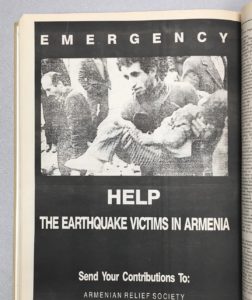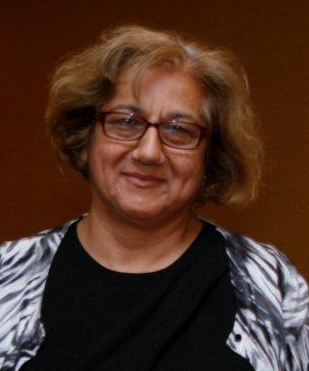From the December 2019 Special Anniversary Magazine Dedicated to the 120th Anniversary of the Hairenik and the 85th Anniversary of the Armenian Weekly

When I look back at the years (1984-1989) that I served as editor of the Armenian Weekly, I deeply appreciate the historical significance of that era. But it was my Hairenik colleagues, our supporters, readers, and visitors that impacted me the most.
It was a revolutionary time in Armenia; the seeds were being planted for the establishment of the independent republic. In addition to the political upheaval, Armenia suffered one of its worst natural disasters in the modern era: the earthquake of 1988. It was also a transitional period for the Hairenik Association. The iconic building at 212 Stuart Street, Boston, was sold. A new, modern Hairenik Building was constructed in the heart of Watertown’s Armenian cultural, religious and commercial neighborhood.
For us, it was also a time of new technology that would upend not only how newspapers are produced, but the entire business model itself.
I recall receiving news reports of the activities of the Karabakh Movement, but it was the photographs of unprecedented public gatherings and demonstrations that helped relay the news. Here in the United States, we had a series of demonstrations that galvanized our community. Participating in those activities and reporting on them was personally rewarding.

However, the event that had the most impact on me has to be the 1988 earthquake. The radio was always on in our office. When we heard the word “Armenia,” we all stopped and listened. Once we realized what had happened, we all broke down and cried. But within a week, the Hairenik was abuzz with activities. A major fundraising effort was underway. The building was open about 16 hours a day to accommodate everyone who wanted to assist. In Jan. 1990, 14 months after the quake, I was in Gyumri. The place was sad, somber and shattered. A few years ago, I went back. The city is so alive and is finally making its way back to its original beauty.
I was the last editor of the Armenian Weekly that worked at 212 Stuart Street. For the generations that never knew the building, it was the home of the Hairenik Publications, including the printing press, and the headquarters of all the organizations that now call 80 Bigelow home. For decades it was the lifeline to the Armenian Revolutionary Federation (ARF) family of organizations in the U.S. Among the many rooms and offices, it had this beautiful ornate hall on the second floor where so many conventions, dances, and banquets had taken place. But as we approached the end of the 20th century, it was evident that the community needed a new type of organizational center.
There were many reasons to move on; no parking, no elevators, the requirement of major renovation, and clean-up of the printing rooms. But the move was highly emotional, nevertheless. It was decided to take the portion of the façade that had the Hairenik etched on it to the new building, and today, those who walk by on the Nichols Avenue side see the piece of 212 Stuart Street that moved with us.
When we left Boston in 1985, the new building was not yet complete. So we were temporarily housed at the St. Stephen’s Church parish house. It was a little bit crowded, but we did not mind. We made it work. A few months later, we packed again and literally pushed our machines down Bigelow Avenue to the Hairenik.
The atmosphere in the new building was enhanced by the daily visitors who came by to pick up their copy of the Armenian language paper and those who just stopped by to discuss current events, whether it was to give us their strong opinion or pass on a piece of information they may have heard. The location was ideal with a parking lot, and you were sure to get a good cup of Armenian coffee. It was a learning experience in so many ways.
I was fortunate to work with two other editors who were highly knowledgeable in Armenian history, literature, and the Western Armenian language: Minas Tololyan and Kevork Donabedian. Now looking back on it, I regret not being a better student. What a wonderful opportunity I had to become fluent in Armenian under their tutelage, and I did not take advantage of it. Apsos.
As I had mentioned, my years at the Hairenik saw a major transition on the production side of the newspaper industry including the Hairenik Publications. When I joined the newspaper staff, we had these two large print setting machines: one for the Armenian language and one for the English language. They performed like typewriters, but on quality print or special paper. They also allowed you to change the font type and size as well as dictate the width of the column. If you had a typo, you would retype the word, sentence or section you wanted to correct and then surgically paste over your article prior to laying out the copy.
Somewhere in the middle of my tenure, we upgraded to personal computers and a page setting computer. You still had to type every article submitted, but at least you were able to do some of the corrections prior to printing the article. We still had to lay out the paper by hand.
Most articles submitted to us came by mail or sometimes by FedEx. It was not unusual for someone to dictate over the phone, which was a challenge. I do recall the day we had a fax machine installed. At the beginning when we heard the machine spewing out a paper, we rushed to see what it was. Needless to say, that novelty wore off quickly.

As I was getting ready to leave the Weekly in May of 1989, an acquaintance who was familiar with computers was trying to explain to me the concept of computer servers, the web, and e-mail and how they will revolutionize the newspaper industry. He strongly urged me to look into it for the Hairenik. I did not understand what he was trying to tell me, but he was so right.
Most of the news we published was at least a couple of weeks old, most of the time older. The delay was not that significant when you printed community news that already had taken place, but sometimes when you included articles about coming events, it would reach the readers after the event took place. We mailed the newspaper out in bulk rate, so if you lived in the midwest, let’s say, it would take a good week for the newspaper to reach you. Those days are long gone and probably forgotten by most.
Throughout the years, there were so many people who helped me put the paper out every week including regular contributors and co-workers. The newspaper staff was very limited. We did not get an assistant editor until the last year I was there; prior to that, I was assigned young Armenian-Americans who served as interns. I lucked out with six interns who worked with me at different times. Thirty years later, they are still active and serving our community.
I would not have done the job for five years if it had not been for the late Tom Vartabedian and the late Leo Sarkisian. I could not have asked for better mentors: both good men, good Armenians and good ARF members. They were always ready to assist me, give me direction, answer questions, provide positive critique and most of all, continually encourage me. In my personal and professional life, I have tried to follow their example.
Although at times it was not easy, I look back on those years at the Weekly with fondness and personal satisfaction. I know I benefited personally and professionally from those years at the Hairenik. It is gratifying to be included in a group of dedicated men and women.



The article was great but was surprised so far no mention of Jimmy Tashjian.